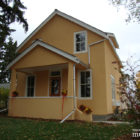Then & Now
St.Albert’s Street names Southeast: How St. Albert’s southeastern streets got their names
March, 2020
Roughly bordered by the Sturgeon in the north, the Henday in the south, and St. Albert Trail in the west, St. Albert’s Southeast developed rapidly starting in the 1950s and 1960s. During this time, as St. Albert grew into a city, it looked to its past and its historical figures for naming inspiration. Today, we can see much of this history in the streets in neighbourhoods like Akinsdale, Braeside, Kingswood and others.
Akins Drive
Named after Lorne Akins, who had a distinguished career in St. Albert as a farmer and public servant. He settled the Braeside and Forest Lawn areas in 1918 and would later serve as chairman of the school board and town councilor. He died in 1971, after which the newly developing subdivision of Akinsdale was named after him.
Arcand Drive
Named after early settler Alfred Arcand and his family. Arcand came west from Quebec with the Northwest Mounted Police, later settling in the St. Albert area in 1880 on River Lot 39. In addition to farming, Mr. Arcand taught French and English and helped establish the local Conservative Party.
Atkinson Place
Susie Atkinson arrived in St. Albert in 1917. She graduated from Olds Agricultural College in 1925 and became a successful farmer and cattle breeder. At a local Sunday school in the 1930s, she began a system of lending out books, for three months at a time, that grew into the town’s first library.
Bishop Street
This street in Braeside honours Bishop Emile Legal, O.M.I. Hailing from France, he arrived in St. Albert in 1881. He was named bishop in 1902 and archbishop in 1913.
Boudreau Road
Quebec-born Lucien Boudreau migrated to Saskatchewan in 1893 and Alberta two years later. He was elected to St. Albert’s first town council in 1904 before rising to mayor in 1909. That same year he was elected to his first term as MLA, a position he would hold until 1921 and again from 1926-1930. At just over five feet tall, he was nicknamed the “Little Napolean of St. Albert.”
Campbell Road
Louis Campbell was an early Métis settler in St. Albert who is mentioned in the parish records. He was here by 1863 and married a local Métis woman named Marie Callihoo.
Corriveau Avenue
An early businessman in St. Albert, Mr. Corriveau with his partner Jules Chave ran a hardware store and blacksmith shop at #18 Vital Avenue.
Cunningham Road
Named after not just one person, but a family of Métis settlers. John Cunningham came from Manitoba and settled in the area, before dying in a buffalo hunt in 1868. His sons had various adventures. Sam and Alfred served in the St. Albert Mounted Rifles during the Riel Rebellion, Henry was elected to St. Albert’s first town council in 1904, and Edward was ordained as a Catholic priest.
Forest Road
Named after Jean Forest, who came to Alberta in
1947 at the age of 21. She separate school board trustee in Edmonton and the
first woman to serve as its chairperson. Later she served on the first Human
Rights Commission in the province, and from 1978 to 1982 she was Chancellor of
the University of Alberta. She represented Edmonton as a senator from 1996 to
1998. Jean
Forest Leadership Academy in Edmonton is
also named after her.
Hebert Road
Named after businessman and politician Cheri Hebert. Upon St. Albert becoming a town in 1904, he was elected as its first mayor. He served for three years before deciding not to run again.
Kingswood Boulevard
Named after the Kingswood neighbourhood that it loops through. Before development began in the 1980s, the area was farmland and popular in winter with cross country skiers in town.
Poirier Avenue
Dr. Richard Poirier was a local doctor and, from
1938 to 1945, Health Officer. He led the St.
Albert Community League upon its formation in the 1940s, which built the
St. Albert Community Hall.
Dr. Poirier was elected mayor in 1943.
Poundmaker Road
Named after Poundmaker, a Plains Cree leader, so named for his ability to corral buffalo in pounds. He came to prominence during the 1885 Rebellion, in which he led his people against the Canadian government. He died in prison in 1886 at the age of 44.
Princeton Crescent
While it’s not known for sure, the name of this Pineview street, which loops around a park of the same name, might be inspired by Antonio Prince. From 1891 to 1894, he represented St. Albert in the territorial legislature in Regina, and in 1898 he opened a law office here.
Veness Road
Named after William Veness, who grew up in the St. Albert area. Besides running a service station from 1949 to 1976, he was town councilor from 1949 to 1951, and mayor from 1951 to 1965. During his time as mayor, St. Albert’s population grew fivefold. t8n













